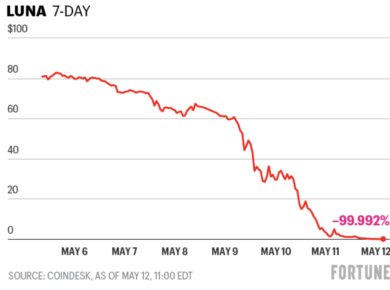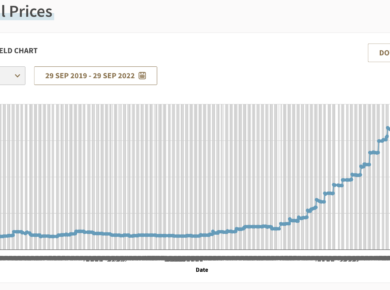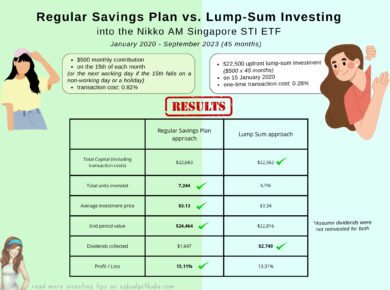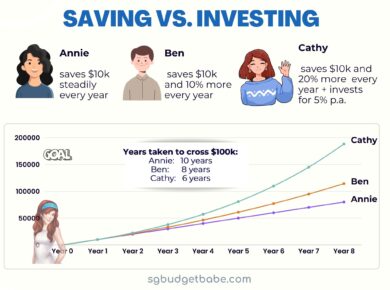If you were paying close attention to the Budget 2018 speech on Monday, as well as my feature on Ask the Finance Minister 2018 earlier this week, you would probably have caught onto:
- The government will be introducing a financial education curriculum for polytechnics and universities.
- Finance Minister Heng Swee Keat emphasized on the importance of individual financial planning and preparations for the future if we are to cope with rising costs.
Up-skill and upgrade yourself was the repeated mantra, which has been echoed for multiple years now. And as I concluded, it seems like the only way out for now is to:
- ensure we (and our dependents) are adequately covered by insurance
- upgrade ourselves and get higher-paying jobs
- build an emergency fund
- invest and plan our finances early so we do not get caught off-guard
Many people favour income investing, where you invest in companies with the financial ability to pay you recurring dividends every quarter or year after year. This contributes passive income where you get paid for simply holding onto your investment. The best part is, it doesn’t matter whether the share price goes up or down, or if the company doesn’t grow as fast as analysts estimate, because you still get paid dividends regardless.
Let’s look at 2 dividend stocks I examined in January 2017 to compare : Sabana REIT vs. Starhub.
|
Sabana REIT
|
Starhub
|
|
|
Share price then
|
$0.35
|
$2.90
|
|
Initial $7000 investment
|
20,000 shares
|
2,414 shares
|
|
Total dividends received in 2017
|
$672
|
$482.80
|
|
Share price today
|
$0.39
|
$2.51
|
|
Investment worth + dividends today
|
$8,472
|
$6,542
|
|
Net returns inclusive of dividends
|
+ 21%
|
– 6.5%
|
What made me choose Sabana REIT over Starhub, and how did I know that Starhub was likely to cut their dividends before the news was even out? Did I have insider information?Not at all, but my own analysis and knowledge told me that it was bound to happen. Similarly, before you invest, I would highly recommend that you should know the following:
- What information should you look at in a company’s annual report?
- What metrics should you use to evaluate dividend stocks?
- What separates a good dividend stock from a poor one?
- How do I know if a company is about to cut or suspend their dividends?
- How do I spot and avoid potentially fraudulent companies?
- What should I look out for when evaluating a REIT?
- Growth drivers that a REIT should have so that you’re likely to earn higher dividends over time
- Financial metrics that a REIT must pass before you invest
You’ll need knowledge and experience in order to sniff out the lousy stocks from the gems, and that’s why I’ve been emphasizing on the importance of getting educated about investments either through books or courses, or a combination of both. I choose to use both.
Previously, I shared about learning value investing through one of my favourite courses, The Investment Quadrant here. However, I received many emails from readers who were more keen on investing for passive income and getting paid through regular dividends, where Dividend Machines would therefore be a better course to learn that.
The good news is, Dividend Machines is now finally open for registration after a long wait! If you’re signing up, I highly recommend that you also attend their class in person to get the most out of your learning.
I had paid for and attended Dividend Machines in 2015, and there were stuff taught that you’ll be hard-pressed to find in books (I kid you not). In fact, the course was so memorable that I still remember, up till this day, the James Bond music playing while we worked on the last exercise to learn a final formula that I feel is worth paying the entire course fee for alone.
 |
| My best investment in 2015 was investing in Dividend Machines, which has paid off handsomely in my investment portfolio 🙂 |
The best part is that beyond just a one-time course, I also get all their future updates they make to their course content. Back in 2015, they did not teach anything about Malaysia REITs, but I can learn that for free this year since I’m a lifetime member (you might even see me back in class again this year for a refresher if you’re attending!). I’ve paid for both their courses and have found them to be one of the best investments in my investing journey, which is why I’ll highly recommend you to go for this as well.
(Of all the course providers in Singapore (and I’ve attended plenty), the only ones I’ve personally recommended and endorse are those taught by The Fifth Person and Dr Wealth, as I feel they offer the best value for money in terms of content and price charged.)
If you’re also keen on learning how to invest for passive income, here’s a reader promo!
You can sign up for Dividend Machines here and get:
- Dividend Machines Training (dividend stocks + Singapore REITs + Malaysia REITs)
- 24/7 unlimited support via the private member’s Q&A forum to ask questions
- Live workshop held in Singapore
- FREE lifetime access to all future course content upgrades
The best part? They’re offering a 30-day money-back guarantee, so if you’re not satisfied, you can always terminate your access and get your money back.
So are all high-yielding dividend stocks a value buy?
Not always, and if you’re not careful, you could end up being burnt like what happened to those who bought this stock previously for its juicy 14% yield. How can we identify the gems from the trash?
You’d better make sure you know, because the company itself / your broker sure isn’t going to tell you!
With love,
Budget BabeSign up here to get $100 off Dividend Machines today!
Limited slots available, as usual, on a first-come-first-served basis.
The registration link and discount will close officially on 18 March 2018.
Sign up here to get $50 off Dividend Machines 2019!
P.S. This is NOT a sponsored post. I reached out to The Fifth Person for a reader’s promo after receiving requests from readers, and am sharing about a course I personally benefited from since 2015.











12 comments
For Dividend Sustainability, I thought the main way is to read the cash flow statement? If so, won't Sabana also be unable to sustain its dividends? It sustained its dividends this FY because it received an equity injection of 80 mil through a rights exercise in 2016
I don't intend to hold onto the remainder of my Sabana stocks for long 😉
What was the intention of purchasing sabana then seeing as this post is about passive income?
Early days of Starhub investors are laughing in their bank account while early days of Sabana investors are weeping. Can we look at snap view of any stock performance?
I purchased Sabana REIT then due to a few factors – I felt it was oversold, and the beaten-down price offered a really attractive yield. Based on 2016's historical dividends, that translated to over 13% in yield (though of cos I didn't think that was sustainable). Discounting the fact that the company's performance wasn't fantastic and that dividend payouts have been reducing over the years, I bought in believing that I would get BOTH capital gains as well as dividend payouts (albeit a reduced one of cos). In my buying thesis, I applied a 50% dividend cut as an estimate + approx 20% recovery in share price (47 cents), and that was compelling enough for me to hit the purchase button. Well, as we all know now, my thesis was slightly off and Sabana did better than what I had projected because I was TOO conservative. I eventually sold off some Sabana shares when the stock price recovered 30% (51 cents) and dividends were cut by 36% instead of the massive 50% I had predicted.
The intention of using Sabana against Starhub in this article as an example was to share a personal example of a choice I made in Jan 2017 (where many readers of this blog met me at a readers' gathering), and how that choice performed from then till now. I also wanted to provide a contrast between a REIT and a non-REIT 🙂
For sure. If I was investing in those early days, I would have picked Starhub as well cos I prefer their business model haha! And if I was already investing in 2010 when Sabana IPOed, I may not have picked it either especially when there were other better REITs to go for 😛
The intention of using Sabana against Starhub in this article as an example was to share a personal example of a choice I made in Jan 2017 (where many readers of this blog met me at a readers' gathering), and how that choice performed from then till now. I also wanted to provide a contrast between a REIT and a non-REIT 🙂
There are many examples that one can use to illustrate how rewarding dividend investing can be, but I wanted to keep it real by using stocks that I personally looked at and bought at the same time period! And readers can relate to my view on Starhub (the 50+ who attended the Jan 2017 workshop where they heard me slam it lol) whereas my brokerage statements will have proof of Sabana 🙂
Hello!
What books do you recommend to supplement my knowledge in investing for income?
Cheers,
Cupcake
Hi, I've written on this topic before! Here's my consolidated list of investment books I would personally recommend 🙂
https://www.sgbudgetbabe.com/2017/07/recommended-books-on-personal-finance.html
Hi, I live in Australia and won't be able to attend the live workshop. Do you think it's still worth signing up for this just for the online materials?
Hey budget babe, do u mind writing an article on how to start trading forex? i tried doing my own research and already know some basic things to take not of like brokerage, leverage etc.. but i don't really know how to get started. Cheers 🙂
Hi, I would say yes because the main value comes in the online course and online member Q&A forum, just that they're offering a free physical workshop in Singapore for those who prefer to learn in person as well 🙂
Also, the formulas and strategies taught are definitely applicable to Australia stocks as well, just that the information may be found in a different format / section in Australia!
Hi Jason! I've written about forex previously on this blog before, but probably won't be writing anything more because as I've mentioned previously, I'm not the biggest fan of forex since I don't do it personally, and therefore I don't think I'm qualified to write about how to start trading forex! These two educational posts below are written in conjunction with forex experts instead:
https://www.sgbudgetbabe.com/2016/03/how-to-protect-yourself-when-trading.html
https://www.sgbudgetbabe.com/2016/04/want-to-be-stay-home-forex-trader-sneak.html
Comments are closed.